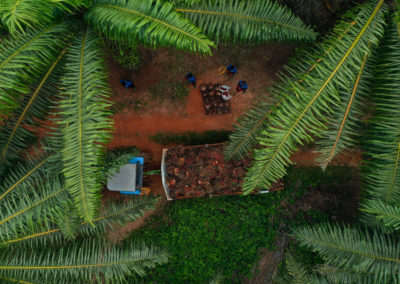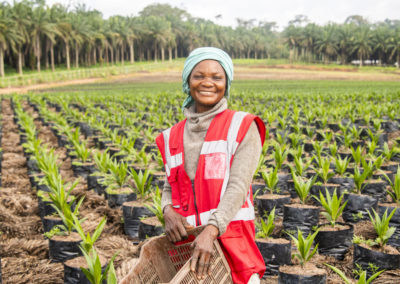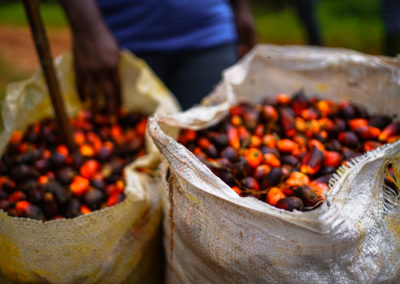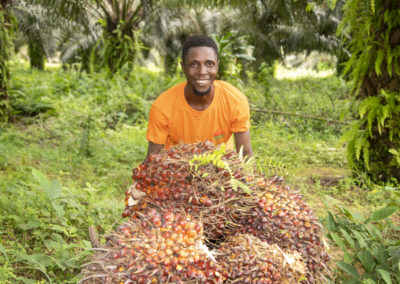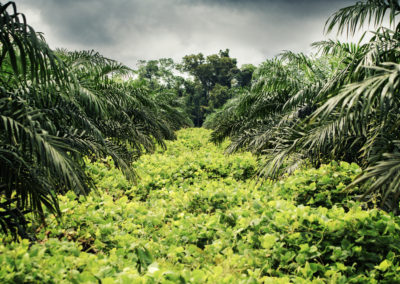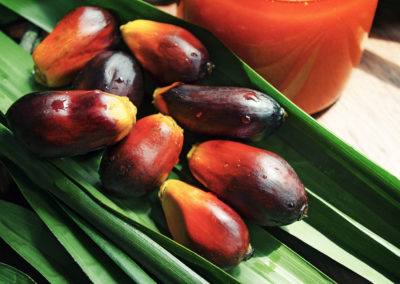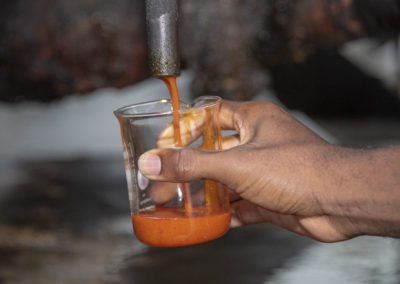Palm oil
81.84 MT
Global production
550 950 T
Socfin’s production
42 800 T
Produced by Socfin’s smallholders
130 200 ha
Palm oil
Palm oil is the most used vegetable oil worldwide. It is produced from the pulp of the oil palm fruits. The oil palm is the most profitable crop in terms of land use and the most sustainable, particularly thanks to its circular production method.
Having an oil yield that is 6 to 8 times higher than other vegetable oils, oil palm cultivation reduces the need for agricultural land and preserves ecosystems.
The oil palm
The oil palm is a species of palm commonly with leaves of almost 5-meter-long and the main supplier of vegetable fat. Its fruits, very rich in oil, grow in bunches, also called “fresh fruit bunches”, at the crown of the plant. The palm oil is extracted from the pulp of the fruits by simple hot pressing, without solvents or chemical additives.
Where does the oil palm grow?
The oil palm is mostly cultivated in West and Central Africa, Southeast Asia and South America. These humid tropical regions offer optimal development conditions.
Oil palm cultivation
The oil palm seeds are planted in a nursery. The young oil palms grow there for a period of about 1 year before they are transplanted into the field. After 3 years of growth, fruit harvesting starts and continues for almost 30 years. By this time, the palm has reached a height of about 15 meters, too tall to be harvested manually. Fruit harvesting is done throughout the year. Every 8 to 10 days, the fruit bunches, whose weight can reach about 15 kilos, are manually harvested using a sickle attached to the end of a pole. Oil palm harvesting is very labor intensive as it involves little mechanization, and thus represents a huge source of direct employment for the local population. The harvest is then transported to the mill.
Palm oil extraction
When the bunches arrive at the mill, they are sterilized under steam, facilitating the detachment of the fruits and preventing the oil to acidify. The bunches are then placed in rotating drums to separate the fruits from the bunches. Before pressing, a mechanical and thermal mixing process prepares the fruits. During pressing, the crude oil is extracted, the fibers and shells are put aside and will be used to produce energy or as organic fertilizers. The last step, the clarification, separates the crude oil from the rest of the juice by decanting in order to obtain a pure crude palm oil.
A circular production method
Palm oil production is a circular production method where each step of the cycle is optimized. Hence, the residual fibers and shells from the production process fuel the biomass boilers. The steam produced by these boilers enters a turbine that generates electricity for the factory and some surrounding villages. The rest of the steam is redistributed and provides the heat needed for the entire process. Palm oil mills are thus energy self-sufficient as they produce renewable energy.
The organic residues from the processing of the bunches are returned to the field and used as organic fertilizers. In addition, all water used is treated in lagoons and does not contain any additives.
Palm oil: an autonomous and sustainable production process.
A sustainable agriculture label exists: CSPO, established by the Roundtable on Sustainable Palm Oil: 5.31 million hectares are certified, representing 16.83 million tons in 2023 or 21% of global production. (31/12/2023 – https://rspo.org/our-impact/outcomes-and-impacts/)
|
|
Palm tree |
Rapeseed |
Soy |
Sunflower |
|
Lifetime |
25 to 35 years |
1 year |
1 year |
/ |
|
Harvested area (233 million ha)1 |
10% |
17% |
60% |
13% |
|
Oil production (260 million T – 2023/24)1 |
90 million T |
30 million T |
59 million T |
21 million T |
|
% of global vegetable oil production (2023/24)2 |
31.5% |
12.1% |
23.9% |
/ |
|
Average yields (T oil/ha)3 |
3.15 |
0.76 |
0.42 |
0.70 |
Sources:
1 – Oil World Annual 2023
2 – Oil World Annual 2024
3 – RSPO report « Impact update 2023 »
Latest news
Jorge Bom Jesus Inaugurates “Agripalma”, producer of 10,000 Tons of palm oil annually
Sao Tome Prime Minister Jorge Bom Jesus inaugurated Thursday an industrial unit named “Agripalma” in the Cauê district, south of Sao Tome, with production capacity 10,000 tons of palm oil per year on an area of 2,100 hectares of palm trees and can absorb more than...
Tight palm oil supplies to support prices in 2024: MPOB
Malaysia's palm oil supply and production will see slight increases in 2024, but limited exports from arch-rival Indonesia, due to its mandate for domestic biodiesel, could support palm oil prices in the current year. To read the full article:...
Forte hausse des importations d’huile de palme en Afrique de l’Ouest en 2023
L’Afrique de l’Ouest a vu ses importations d’huile de palme en provenance de la Malaisie grimper de près de 47% en 2023 pour atteindre 978 156 tonnes, selon les données du Malaysian Palm Oil Council (Mpoc). Le Nigeria est le premier importateur de la zone avec 304 043...

